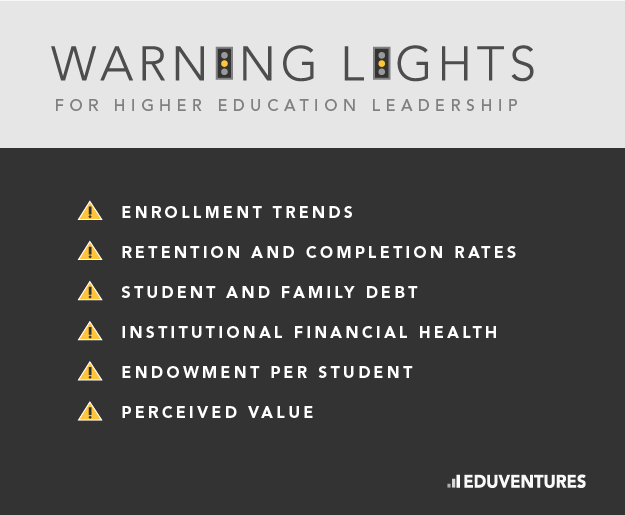The following excerpt from a recent Eduventures report, The Higher Education Highway: Heeding Your Warning Lights, details the trends that have driven two institutions to the breakdown lane. The full essay outlines the key metrics institutional leaders should monitor and culminates with a comprehensive dashboard that scores these metrics to gauge institutional health.
Eduventures invites college presidents to share the full report and self-assessment/scorecard with their key stakeholders (cabinet, trustees) during the summer months, as they prepare for the start of the new academic year.
A funny thing happened to Sweet Briar College (SBC) on the higher education highway: It ran out of gas. The University of Maine System (UMS) is not far behind, with enrollments falling across its seven campuses and a projected budget deficit of $90 million by 2019-20. The sad truth is that hundreds of colleges are also seeing the “low fuel” warning light appear on their financial dashboards, each hoping that a gas station is just ahead.

The Trends and Warning Signs are Clear
- Decaying financials. According to a 2013 survey conducted by Inside Higher Education and Gallup, 60% of college chief financial officers feel that a significant number of higher education institutions are facing an “existential financial crisis.” The regulators agree: Between 2009 and 2013, the number of colleges’ credit ratings that Moody’s Investor Services has downgraded outpaced upgrades by nearly five to one, according to The Chronicle of Higher Education. On top of all this, the National Association of College and University Business Officers reports that the average discount rate went up 6.3% in 2013-14. In this period, discounts rose faster than tuition; for every one dollar rise in tuition, on average, net tuition went up only 20 cents.
- Enrollments are shrinking. Enrollment goals are more out of reach than ever before. 46% of admissions directors reported being “very concerned” about meeting their numbers, and another 30% were “moderately concerned.” Results from the National Association for College Admissions Counseling’s annual survey indicate that, in recent years, nearly one half of all responding institutions did not meet their enrollment goals by the traditional May 1 deadline. As the student population of adult learners remains flat and the number of institutions offering degrees to adult learners continues to rise, colleges are experiencing more competition for these students.
- A growing number of schools are closing their doors. The number of private four-year colleges that have closed or been acquired has doubled from about five per year before 2008 to about 10 per year since, according to a 2013 Vanderbilt University study. Today, many private colleges face deep financial uncertainty if they fail to meet their enrollment goals. Higher education is in the midst of a transformation. The question for every stakeholder at every school is what steps you need to take today to ensure that you survive and thrive in the future. Answering this question has to start with an honest assessment of where you are and, more importantly, how you got there.
Warning Lights


